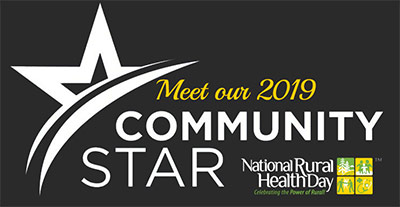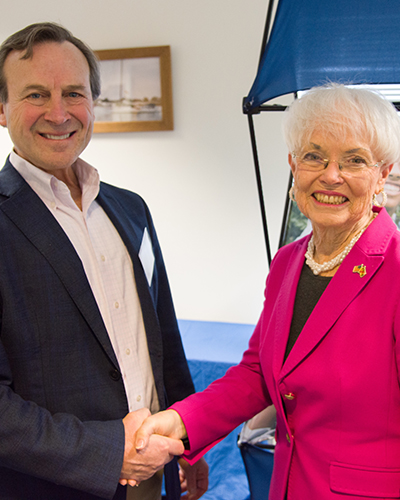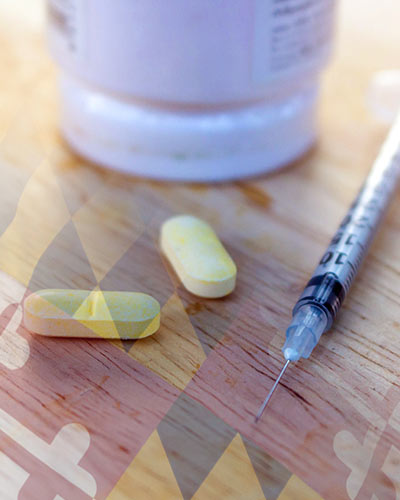November 20, 2019

Dr. Weintraub’s Telemedicine Treatment for Opioid Disorders Has Been Pathbreaking for Rural Communities
Eric Weintraub, MD, Associate Professor of Psychiatry at the University of Maryland School of Medicine and Head of the Division of Alcohol & Drug Abuse, was named “Community Star” by the National Organization of State Offices of Rural Health.
The award is being officially announced during National Rural Health Day, an annual day of recognition, shining a light on those who serve the vital health needs of an estimated 57 million people living in rural America.
Weintraub was recognized for his telemedicine work to help bring treatment for opioid disorders to rural parts of the state of Maryland. Dr. Weintraub is an expert in the treatment of opioid dependence with Medication Assisted Treatment. He has helped develop innovative programs in providing Medication Assisted Treatment to underserved rural areas via telemedicine and in engaging opioid dependent patients in the Emergency Department with Medication Assisted Treatment.
 In April Dr. Weintraub announced UMSOM’s partnership with Caroline County Health Department, Maryland Department of Health, and the Maryland Opioid Operational Command Center to launch the Eastern Shore Mobile Care Collaborative (ESMCC). This is a mobile system designed to provide state-of-the-art treatment for opioid disorders for those in need on the Maryland Eastern shore. The ESMCC builds upon a commitment among local health officials and UMSOM addiction experts to provide service to those in need in the most rural parts of the state. The service provided in the MTU is a combination of on-site diagnosis and treatment with medication-based treatment for opioid addiction via telemedicine to patients located on Maryland’s eastern shore.
In April Dr. Weintraub announced UMSOM’s partnership with Caroline County Health Department, Maryland Department of Health, and the Maryland Opioid Operational Command Center to launch the Eastern Shore Mobile Care Collaborative (ESMCC). This is a mobile system designed to provide state-of-the-art treatment for opioid disorders for those in need on the Maryland Eastern shore. The ESMCC builds upon a commitment among local health officials and UMSOM addiction experts to provide service to those in need in the most rural parts of the state. The service provided in the MTU is a combination of on-site diagnosis and treatment with medication-based treatment for opioid addiction via telemedicine to patients located on Maryland’s eastern shore.
About the University of Maryland School of Medicine
Now in its third century, the University of Maryland School of Medicine was chartered in 1807 as the first public medical school in the United States. It continues today as one of the fastest growing, top-tier biomedical research enterprises in the world -- with 43 academic departments, centers, institutes, and programs; and a faculty of more than 3,000 physicians, scientists, and allied health professionals, including members of the National Academy of Medicine and the National Academy of Sciences, and a distinguished recipient of the Albert E. Lasker Award in Medical Research. With an operating budget of more than $1 billion, the School of Medicine works closely in partnership with the University of Maryland Medical Center and Medical System to provide research-intensive, academic and clinically based care for more than 1.2 million patients each year. The School has over 2,500 students, residents, and fellows, and more than $540 million in extramural funding, with most of its academic departments highly ranked among all medical schools in the nation in research funding. As one of the seven professional schools that make up the University of Maryland, Baltimore campus, the School of Medicine has a total workforce of nearly 7,000 individuals. The combined School and Medical System (“University of Maryland Medicine”) has an annual budget of nearly $6 billion and an economic impact more than $15 billion on the state and local community. The School of Medicine faculty, which ranks as the 8th highest among public medical schools in research productivity, is an innovator in translational medicine, with 600 active patents and 24 start-up companies. The School works locally, nationally, and globally, with research and treatment facilities in 36 countries around the world. Visit medschool.umaryland.edu
Contact
Office of Public Affairs
655 West Baltimore Street
Bressler Research Building 14-002
Baltimore, Maryland 21201-1559
Contact Media Relations
(410) 706-5260
Related stories

Friday, August 27, 2021
UM School of Medicine Study Finds Mobile Telemedicine Unit as Effective as Traditional Clinics to Treat Opioid Addiction in Rural Areas
Rural regions in the U.S. have been disproportionately affected by the opioid epidemic, while also having the fewest number of programs to treat opioid use disorder. In an effort to remedy this dire health issue, University of Maryland School of Medicine (UMSOM) researchers reconfigured a recreational vehicle (RV) as a telemedicine mobile treatment unit to determine whether it could provide effective screening and treatment to individuals with opioid use disorder in rural areas. Their research, published today in the Journal of the American Medical Association (JAMA) Network Open, found that the innovative approach to be as successful as traditional brick-and-mortar treatment clinics. The study also found a significant reduction in illicit opioid use among the majority of patients treated on the mobile unit, as well as sustained success in these patients continuing therapy to avoid relapse.

Wednesday, January 23, 2019
UMSOM'S Opioid Addiction Treatment Experts Receive Funding from CareFirst for Telemedicine Network
Addiction experts at the University of Maryland School of Medicine (UMSOM) received a $212,171 grant from CareFirst to expand access to medication assisted treatment (MAT) for opioid addiction via telemedicine to patients located on Maryland’s eastern shore.

Friday, January 05, 2018
Fighting Opioid Addiction from Baltimore to Garrett County: University of Maryland School of Medicine Rises to the Challenge
The opioid epidemic has been deadly for Maryland. In 2016, more than 2000 people in the state died from overdoses; in 2017, deaths rose another 40 percent, and deaths from the powerful synthetic opioid fentanyl were up nearly 140 percent. Last year, Gov. Larry Hogan declared a state of emergency in response to the opioid epidemic, saying the state needs an “all-hands-on-deck approach.”
